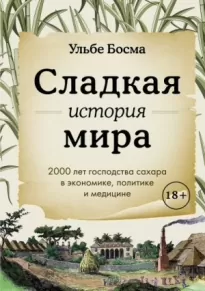Сладкая история мира. 2000 лет господства сахара в экономике, политике и медицине

- Автор: Ульбе Босма
- Жанр: Научная литература / Исторические приключения / История: прочее
Читать книгу "Сладкая история мира. 2000 лет господства сахара в экономике, политике и медицине"
11. Пролетариат
1 Sam R.Sweitz, «The Production and Negotiation of Working-Class Space and Place at Central Aguirre, Puerto Rico,» Journal of the Society for Industrial Archeology 36, no. 1 (2010): 30.
2 Maureen Tayal, «Indian Indentured Labour in Natal, 1890–1911,» Indian Economic&Social History Review 14, no. 4 (1977): 521–522, 526, 544; Duncan Du Bois, «Collusion and Conspiracy in Colonial Natal: A Case Study of Reynolds Bros and Indentured Abuses 1884–1908,» Historia: Amptelike Orgaan 60, no. 1 (2015): 98–102.
3 Bill Albert, «The Labour Force on Peru’s Sugar Plantations 1820–1930,» in Crisis and Change in the International Sugar Economy 1860–1914, ed. Bill Albert and Adrian Graves (Norwich, England: ISC Press, 1984), 203, 206.
4 Ulbe Bosma and Jonathan Curry-Machado, «Two Islands, One Commodity: Cuba, Java, and the Global Sugar Trade (1790–1930),» New West Indian Guide 86, nos. 3–4 (2012): 253–254. Об Индии см.: Ulbe Bosma, The Sugar Plantation in India and Indonesia: Industrial Production, 1770–2010 (Cambridge: Cambridge University Press, 2013), 270.
5 Оценка дана на основе предположения, согласно которому объем свекловичного неочищенного сахара, получаемый с гектара в 1920 году, составлял в среднем пять тонн (экстраполяция с объема в четыре тонны, получаемого с гектара в 1890 году), а на каждый гектар требовался по меньшей мере один рабочий. См.: H.Paasche, Zuckerindustrie und Zuckerhandel der Welt (Jena, Germany: G. Fischer, 1891), 43.
5 Ulbe Bosma, The Making of a Periphery: How Island Southeast Asia Became a Mass Exporter of Labor (New York: Columbia University Press, 2019), 81–88.
7 Eleanor C.Nordyke, Y.Scott Matsumoto, The Japanese in Hawaii: Historical and Demographic Perspective (Honolulu: Population Institute, East-West Center, 1977), 164.
8 J.Vincenza Scarpaci, «Labor for Louisiana’s Sugar Cane Fields: An Experiment in Immigrant Recruitment,» Italian Americana 7, no. 1 (1981): 20, 33, 34; J.P.Reidy, «Mules and Machines and Men: Field Labor on Louisiana Sugar Plantations, 1887–1915,» Agricultural History 72, no. 2 (1998): 188.
9 M.Bejarano, «La inmigración a Cuba y la política migratoria de los EE.UU. (1902–1933),» Estudios Interdisciplinarios de América Latina y el Caribe 42, no. 2 (1993): 114.
10 Patrick Bryan, «The Question of Labour in the Sugar Industry of the Dominican Republic in the Late Nineteenth and Early Twentieth Century,» Social and Economic Studies 29, nos. 2–3 (1980): 278–283; April J.Mayes, The Mulatto Republic: Class, Race, and Dominican National Identity (Gainesville: University Press of Florida, 2015), 83; Samuel Martínez, «From Hidden Hand to Heavy Hand: Sugar, the State, and Migrant Labor in Haiti and the Dominican Republic,» Latin American Research Review 34, no. 1 (1999): 68.
11 Edward Paulino, Dividing Hispaniola: The Dominican Republic’s Border Campaign against Haiti, 1930–1961 (Pittsburgh: Pittsburgh University Press, 2016), 54; Richard Lee Turits, «A World Destroyed, a Nation Imposed: The 1937 Haitian Massacre in the Dominican Republic,» Hispanic American Historical Review 83, no. 3 (2002): 590–591.
12 Jorge L.Giovannetti, Black British Migrants in Cuba: Race, Labor, and Empire in the Twentieth-Century Caribbean, 1898–1948 (Cambridge: Cambridge University Press, 2000), Kindle, 44.
13 Louis A.Pérez, «Politics, Peasants, and People of Color: The 1912 ‘Race War’ in Cuba Reconsidered,» Hispanic American Historical Review 66, no. 3 (1986): 524–525.
14 César J.Ayala, American Sugar Kingdom: The Plantation Economy of the Spanish Caribbean, 1898–1934 (Chapel Hill: University of North Carolina, 1999), 172; Barry Carr, «Identity, Class, and Nation: Black Immigrant Workers, Cuban Communism, and the Sugar Insurgency 1925–1934,» Hispanic American Historical Review 78, no. 1 (1998): 83.
15 Klaus J.Bade and Jochen Oltmer, «Polish Agricultural Workers in Prussia-Germany from the Late 19th Century to World War II,» in The Encyclopedia of Migration and Minorities in Europe: From the 17th Century to the Present, ed. Klaus J.Bade et al. (Cambridge: Cambridge University Press, 2011), 595–597.
16 Dirk Musschoot, Van Franschmans en Walenmannen: Vlaamse Seizoenarbeiders in den Vreemde in de 19de en 20ste Eeuw (Tielt, Belgian: Lannoo, 2008), 32–33, 38; E.Sommier, «Les cahiers de l’industrie française: V: Le sucre,» Revue des Deux Mondes (1829–1971) 2, no. 2 (1931): 354.
17 Musschoot, Van Franschmans, 51, 83, 111, 246; Christiaan Gevers, De Suikergastarbeiders: Brabantse Werknemers bij de Friesch-Groningsche Suikerfabriek (Bedum, the Netherlands: Profiel, 2019), 20.
18 Mark Wyman, Round-Trip to America: The Immigrants Return to Europe, 1880–1930 (Ithaca, NY: Cornell University Press, 1993), 37–38, 129.
19 Gary Okihiro, Cane Fires: The Anti-Japanese Movement in Hawaii (Philadelphia: Temple University Press, 1991), 27.
20 Allan D.Meyers, «Material Expressions of Social Inequality on a Porfirian Sugar Hacienda in Yucatán, Mexico,» Historical Archaeology 39, no. 4 (2005): 118. См.: John Kenneth Turner, Barbarous Mexico: An Indictment of a Cruel and Corrupt System (London: Cassell, 1911).
21 См., например: Matthew Casey, «Haitians’ Labor and Leisure on Cuban Sugar Plantations: The Limits of Company Control,» New West Indian Guide 85, nos. 1–2 (2011): 14.
22 G.R.Knight, Commodities and Colonialism: The Story of Big Sugar in Indonesia, 1880–1942 (Leiden: Brill, 2013), 199; Bosma, The Sugar Plantation, 190.
23 Bosma, The Sugar Plantation, 177.
24 Jacques Adélaïde-Merlande, Les origines du mouvement ouvrier en Martinique 1870–1900 (Paris: Ed. Karthala, 2000), 113, 127, 139, 170, 173.
25 Rosemarijn Hoefte, «Control and Resistance: Indentured Labor in Suriname,» New West Indian Guide 61, nos. 1–2 (1987): 8, 11–12.
26 R.W.Beachey, The British West Indies Sugar Industry in the Late 19th Century (Oxford: B. Blackwell, 1957), 153.
27 West India Royal Commission, Report of the West India Royal Commission (London: Printed for Her Majesty’s Stationery Office by Eyre and Spottiswoode, 1897), 8, 17, 64, 66.
28 См.: Walter Rodney, «The Ruimveldt Riots: Demerara, British Guiana, 1905,» in Caribbean Freedom: Economy and Society from Emancipation to the Present: A Student Reader, ed. Hilary McD. Beckles and Verene Shepherd (Kingston, Jamaica: Ian Randle, 1996), 352–358.
29 US Congress and House Committee on Ways and Means, Reciprocity with Cuba Hearings before the Committee on Ways and Means, Fifty-Seventh Congress, First Session January 15, 16, 21, 22, 23, 24, 25, 28, 29, 1902 (Washington, DC: Government Printing Office, 1902), 175, 194.
30 Elizabeth S.Johnson, «Welfare of Families of Sugar-Beet Laborers,» Monthly Labor Review 46, no. 2 (1938): 325; Dennis Nodín Valdés, «Mexican Revolutionary Nationalism and Repatriation during the Great Depression,» Mexican Studies 4, no. 1 (1988): 3.
31 О Кубе, см.: Giovannetti, Black British Migrants, 56.
32 Max Weber, Die Verhältnisse der Landarbeiter im ostelbischen Deutschland: Preussische Provinzen Ostu. Westpreussen, Pommern, Posen, Schlesien, Brandenburg, Grossherzogtümer Mecklenburg, Kreis Herzogtum Lauenburg (Leipzig: Duncker and Humblot, 1892), 491.
33 Manuel Gamio, Mexican Immigration to the United State: A Study of Human Migration and Adjustment (New York: Arno Press, 1969), 31.
34 Kathleen Mapes, Sweet Tyranny: Migrant Labor, Industrial Agriculture, and Imperial Politics (Urbana: University of Illinois Press, 2009), 128.
35 Dennis Nodín Valdés, «Settlers, Sojourners, and Proletarians: Social Formation in the Great Plains Sugar Beet Industry, 1890–1940,» Great Plains Quarterly 10, no. 2 (1990): 118.
36 Jim Norris, North for the Harvest: Mexican Workers, Growers, and the Sugar Beet Industry (St. Paul: Minnesota Historical Society Press, 2009), 43n.7, 44.
37 Elizabeth S.Johnson, «Wages, Employment Conditions, and Welfare of Sugar Beet Laborers,» Monthly Labor Review 46, no. 2 (1938): 325; Valdés, «Mexican Revolutionary,» 4, 21–22.
38 Johnson, «Wages, Employment Conditions,» 322.
39 Louis Fiset, «Thinning, Topping, and Loading: Japanese Americans and Beet Sugar in World War II,» Pacific Northwest Quarterly 90, no. 3 (1999): 123.
40 Victor S.Clark, Labor Conditions in Hawaii: Letter from the Secretary of Labor Transmitting the Fifth Annual Report of the Commissioner of Labor Statistics on Labor Conditions in the Territory of Hawaii for the Year 1915 (Washington, DC: Government Printing Office, 1916), 63.
41 Melinda Tria Kerkvliet, Unbending Cane: Pablo Manlapit, a Filipino Labor Leader in Hawaii (Honolulu: Office of Multicultural Student Services, University of Hawaii at Mānoa, 2002), 23–28; Okihiro, Cane Fires, 71–76, 84–98.
42 US Congress, House Committee on Immigration, and Naturalization, Labor Problems in Hawaii. Hearings before the Committee on Immigration and Naturalization, House of Representatives, 67th Congress, 1st Session on H.J. Res. 158… Serial 7 – Part 1–2, June 21 to June 30 and July 7, July 22, 27 and 29, Aug. 1, 2, 3, 4, 10, and 12, 1921 (Washington, DC: Government Printing Office, 1921), 278–279.
43 US Congress, House Committee on Immigration, and Naturalization, Labor Problems in Hawaii, 361.
44 Kerkvliet, Unbending Cane, 25; Okihiro, Cane Fires, 52.
45 F.P.Barajas, «Resistance, Radicalism, and Repression on the Oxnard Plain: The Social Context of the Betabelero Strike of 1933,» Western Historical Quarterly 35 (2004): 33; Tomás Almaguer, «Racial Domination and Class Conflict in Capitalist Agriculture: The Oxnard Sugar Beet Workers’ Strike of 1903,» Labor History 25, no. 3 (1984): 339.
46 Kerkvliet, Unbending Cane, 59–60.
47 См., например: Humberto García Muñiz, Sugar and Power in the Caribbean: The South Porto Rico Sugar Company in Puerto Rico and the Dominican Republic, 1900–1921 (San Juan, Puerto Rico: La Editorial, 2010), 409; Albert, «The Labour Force on Peru’s Sugar Plantations 1820–1930,» 213–214.
48 Elsbeth Locher-Scholten, Ethiek in Fragmenten: Vijf Studies over Koloniaal Denken en Doen van Nederlanders in de Indonesische archipel, 1877–1942 (Utrecht: Hes Publishers, 1981), 103.
49 Barry Carr, «Mill Occupations and Soviets: The Mobilisation of Sugar Workers in Cuba 1917–1933,» Journal of Latin American Studies 28, no. 1 (1996): 134.
50 Oscar Zanetti, «The Workers’ Movement and Labor Regulation in the Cuban Sugar Industry,» Cuban Studies, no. 25 (1995): 185.
51 John Ingleson, Workers, Unions and Politics: Indonesia in the 1920s and 1930s (Leiden: Brill, 2014), 28.
52 О социально-бытовых условиях см.: I.T.Runes, General Standards of Living and Wages of Workers in the Philippine Sugar Industry (Manila: Philippine Council Institute of Pacific Relations, 1939).
53 Carr, «Mill Occupations,» 132–133.
54 Ken Post, Arise Ye Starvelings: The Jamaican Labour Rebellion of 1938 and Its Aftermath (The Hague: Nijhoff, 1978), 3; Alejandro de la Fuente, «Two Dangers, One Solution: Immigration, Race, and Labor in Cuba, 1900–1930,» International Labor and Working-Class History 51 (1997): 43–45; M.C.McLeod, «Undesirable Aliens: Race, Ethnicity, and Nationalism in the Comparison of Haitian and British West Indian Immigrant Workers in Cuba, 1912–1939,» Journal of Social History 31, no. 3 (1998): 604.
55 Hudson, Bankers and Empire, 217–218, 269.
56 Ayala, American Sugar Kingdom, 118.
57 Peter James Hudson, Bankers and Empire: How Wall Street Colonized the Caribbean (Chicago: University of Chicago Press, 2018), 264–265; Raymond E.Crist, «Sugar Cane and Coffee in Puerto Rico, II: The Pauperization of the Jíbaro; Land Monopoly and Monoculture,» American Journal of Economics and Sociology 7, no. 3 (1948): 330; J.A.Giusti-Cordero, «Labour, Ecology and History in a Puerto Rican Plantation Region: ‘Classic’ Rural Proletarians Revisited,» International Review of Social History 41 (1996): 53–82.
58 См.: Victor Selden Clark, Porto Rico and Its Problems (Washington, DC: Brookings Institution, 1930); Matthew O. Edel, «Land Reform in Puerto Rico, 1940–1959,» Caribbean Studies 2, no. 3 (1962): 26; Hudson, Bankers and Empire, 263–267.
59 Цит. по: Robert Whitney, State and Revolution in Cuba: Mass Mobilization and Political Change, 1920–1940 (Chapel Hill: University of North Carolina Press, 2001), 119.
60 Robert Whitney, «The Architect of the Cuban State: Fulgencio Batista and Populism in Cuba, 1937–1940,» Journal of Latin American Studies 32, no. 2 (2000): 442.
61 Whitney, State and Revolution, 155; Giovannetti, Black British Migrants, 240.
62 См., например: Édouard de Lepine, La crise de février 1935 à la Martinique: La marche de la faim sur Fort-de-France (Paris: L’Harmattan, 1980); O.Nigel Bolland, On the March: Labour Rebellions in the British Caribbean, 1934–39 (Kingston, Jamaica: Ian Randle, 1995), 280.
63 Bolland, On the March, 279–285, 340–356.
64 Jeremy Seekings, «British Colonial Policy, Local Politics, and the Origins of the Mauritian Welfare State, 1936–50,» Journal of African History 52, no. 2 (2011): 162.
65 Post, Arise ye Starvelings, 350–351; Bolland, On the March, 299, 301, 312–313, 325.
66 Carl Henry Fe, «Better Must Come: Sugar and Jamaica in the 20th Century,» Social and Economic Studies 33, no. 4 (1984): 21–22, 24.
67 Edward D.Beechert, Working in Hawaii: A Labor History (Honolulu: University of Hawaii Press, 1985), 272–273.
68 US Department of Labor, Labor Unionism in American Agriculture (Washington, DC: Government Printing Office, 1945), 83, 87.
69 Barajas, «Resistance, Radicalism,» 37, 41–42, 48; Department of Labor, Labor Unionism, 96, 129; Carlos Bulosan, America Is in the Heart: A Personal History (Manila: National Bookstore, 1973), 195, 196.
70 Department of Labor, Labor Unionism, 59, 238–253, 387.
71 Доклад Игэна включен в источник: National Labor Relations Act: Hearings before the United States House Special Committee to Investigate National Labor Relations Board, Seventy-Sixth Congress, Third Session, on May 2, 3, 1940, vol. 22 (Washington, DC: Government Printing Office, 1945), 4525–4526.
72 J.Norris, «Growing up Growing Sugar: Local Teenage Labor in the Sugar Beet Fields, 1958–1974,» Agricultural History 79, no. 3 (2005): 301.
73 См.: Ramiro Guerra, Azúcar y población en las Antillas (Havana: Cultural, 1927), 86.
74 A.M.P.A.Scheltema, The Food Consumption of the Native Inhabitants of Java and Madura: Done into English by A.H.Hamilton (Batavia: Ruygrok / National Council for the Netherlands and the Netherlands Indies of the Institute of Pacific Relations, 1936), 62. См. также: Runes, General Standards of Living; Yoshihiro Chiba, «The 1919 and 1935 Rice Crises in the Philippines: The Rice Market and Starvation in American Colonial Times,» Philippine Studies 58, no. 4 (2010): 540.
75 Samuel Farber, Revolution and Reaction in Cuba, 1933–1960: A Political Sociology from Machado to Castro (Middletown, CT: Wesleyan University Press, 1976), 85.
76 Whitney, «The Architect,» 454, 459.
77 См.: Edel, «Land Reform.»
78 Ulbe Bosma, «The Integration of Food Markets and Increasing Government Intervention in Indonesia: 1815–1980s,» in An Economic History of Famine Resilience, ed. Jessica Dijkman and Bas Van Leeuwen (London: Routledge, 2019), 152–154.
79 J.van Gelderen, The Recent Development of Economic Foreign Policy in the Netherlands East Indies (London: Longmans, Green, 1939), 84.
80 William Arthur Lewis, Labour in the West Indies: the Birth of a Workers’ Movement (London: New Beacon Books, 1977), 16.
81 William Arthur Lewis, «Economic Development with Unlimited Supplies of Labour,» Manchester School of Economic and Social Studies 22, no. 2 (1954): 183.
82 Norman Girvan, «W.A.Lewis, the Plantation School and Dependency: An Interpretation,» Social and Economic Studies 54, no. 3 (2005): 215, 218; W. Arthur Lewis, Growth and Fluctuations 1870–1913 (London: George Allen, 1978), 161, 200.
83 W.Arthur Lewis, The Theory of Economic Growth (London: Allen and Unwin, 1955), 410.
84 Слова Льюиса цитируются по источнику: Girvan, «W. A. Lewis,» 205–206.
85 Seekings, «British Colonial Policy,» 165.
86 Guerra, Azúcar y población, 117, 23.
87 Gilberto Freyre, The Mansions and the Shanties (Sobrados e Mucambos): The Making of Modern Brazil (New York: A.A.Knopf, 1968), 135–136, 407.
88 Josué de Castro, Geography of Hunger: With a Foreword by Lord Boyd Orr (London: Victor Gollancz, 1952), 113.
89 Castro, Geography of Hunger, 117.
9 °Castro, Geography of Hunger, 198; John Boyd Orr, Food Health and Income: Report on a Survey of Adequacy of Diet in Relation to Income (London: Macmillan, 1937), 11.
91 Celso Furtado, The Economic Growth of Brazil: A Survey from Colonial to Modern Times (Berkeley: University of California Press, 1968), 109.
92 Manuel Correia de Andrade, The Land and People of Northeast Brazil (Albuquerque: University of New Mexico Press, 1980), 193–206.





